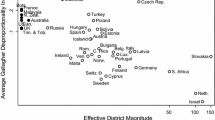Abstract
A sociophysical model for opinion dynamics is shown to embody a series of recent western hung national votes all set at the unexpected and very improbable edge of a fifty-fifty score. It started with the Bush–Gore 2000 American presidential election, followed by the 2002 Stoiber–Schröder, then the 2005 Schröder–Merkel German elections, and finally the 2006 Prodi-Berlusconi Italian elections. In each case, the country was facing drastic choices, the running competing parties were advocating very different programs and millions of voters were involved. Moreover, polls were given a substantial margin for the predicted winner. While all these events were perceived as accidental and isolated, our model suggests that indeed they are deterministic and obey to one single universal phenomena associated to the effect of contrarian behavior on the dynamics of opinion forming. The not hung Bush–Kerry 2004 presidential election is shown to belong to the same universal frame. To conclude, the existence of contrarians hints at the repetition of hung elections in the near future.
Similar content being viewed by others
References
Borghesi, C., Galam, S.: Chaotic, staggered, and polarized dynamics in opinion forming: the contrarian effect. Phys. Rev. E (2006) (in press)
Caruso F., Castorina P. (2005): Opinion dynamics and decision of vote in bipolar political systems. Int. J. Mod. Phys. C 16: 1473
de la Lama M.S., Lòpez J.M., Wio H.S. (2005): Spontaneous emergence of contrarian-like behaviour. in an opinion spreading mode. Eurphys. Lett. 72(5): 851
Dreman, D.: Contrarian Investment Strategies. Random House New York (1979); The Next Generation. Simon and Schuster, New York (1998)
Galam, S.: Les rformes sont-elles impossibles? Le Monde (28 mars) 18 (2000)
Galam S. (2002): Minority opinion spreading in random geometry. Rapid Note B 25: 403
Galam S. (2003): Modeling rumors: the no plane pentagon French Hoax. Case Physica A 320, 571
Galam S. (2004): Contrarian deterministic effects on opinion dynamics: the hung elections scenario. Physica A 333, 453
Galam S. (2005a): Heterogeneous beliefs, segregation, and extremism in the making of public opinions. Phys. Rev. 71: 046123
Galam S. (2005b): Local dynamics vs. social mechanisms: A unifying frame. Europhys. Lett. 70(6): 705
Galam S., Moscovici S. (1991): Towards a theory of collective phenomena: consensus and attitude changes in groups. Eur. J. Social Psy. 21, 49
Galam S., Gefen Y., Shapir Y. (1982): Sociophysics: a mean behavior model for the process of strike. Math. J. Sociol. 9: 1
Galam S., Chopard B., Masselot A., Droz M. (1998): Competing species dynamics. Eur. Phys. J. B 4: 529
Le Hir, P.: Les mathmatiques sinvitent dans le dbat europen. Le Monde 26 (Fevrier), 23 (2005)
Solomon S., Weisbuch G., de Arcangelis L., Jan N., Stauffer D. (2000): Social percolation models. Physica A 277 (1–2): 239
Stauffer D., Sa Martins J.S. (2004): Simulation of Galam’s contrarian opinions. Physica A 334, 558
Sznajd-Weron K., Sznajd-Weron J. (2002): Opinion evolution in closed community. Int. J. Mod. Phys. C 11: 1157
Tessone C.J., Toral R., Amengual P., Wio H.S., San Miguel M. (2004): Neighborhood models of minority opinion spreading. Eur. Phys. J. B 39: 535
Wikipedia, the free encyclopedia: http://en.wikipedia.org
Author information
Authors and Affiliations
Corresponding author
Rights and permissions
About this article
Cite this article
Galam, S. From 2000 Bush–Gore to 2006 Italian elections: voting at fifty-fifty and the contrarian effect. Qual Quant 41, 579–589 (2007). https://doi.org/10.1007/s11135-007-9072-8
Published:
Issue Date:
DOI: https://doi.org/10.1007/s11135-007-9072-8




